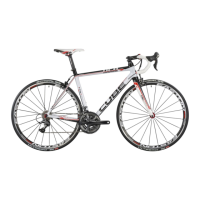5. Have the brake pad and brake disk wear
checked at a specialist workshop (see
here also Chapter 11):
•
The brake pads must not be worn down
beyond the wear indicator.
•
The brake disk must not be below the mini-
mum thickness.
•
You can nd the minimum thickness in
the accompanying component operating
instructions.
6. Check your brake disks for dirt, especially
oil and grease.
•
Dirty brake disks must be cleaned immedia-
tely (see Chapter 11)
When touring for several days brake disk,
brake blocks and brake pads can wear a
lot.
When touring like this carry spare brake
blocks and replacement pads with you.
Only replace them yourself if you are
familiar with this job. Please consult your
dealer.
If you cannot replace them yourself have
them done by a trained specialist.
7.8.5 Check back-pedal brake
1. Ride at walking pace.
2. Tread „backwards“ against the direction
of drive.
3. The rear wheel must be able to be braked
sharply in this way.
7.9 Check drive train and chain
1. Turn the right hand crank counter clock-
wise and note the chain rings and the
pinion cassette.
•
The chain rings and pinions must have no
axial run-out.
•
There must be no debris present. Remove
the latter if this is easily possible.
2. Press the left crank in the position shown
against the chain stay.
•
You should feel no play.
•
There must be no audible creaking or ratt-
ling sounds.
3. Check the chain for damage.
•
At no point on the chain should there be, for
example, any damaged chain side shplates,
protruding rivet pins or seized and immobile
chain links.
4. In a static position turn the right crank
counter to the direction of drive and
observe running of the chain at the gear
change rollers on the change mechanism.
5. The chain must run smoothly over the
change rollers and must not jump.

